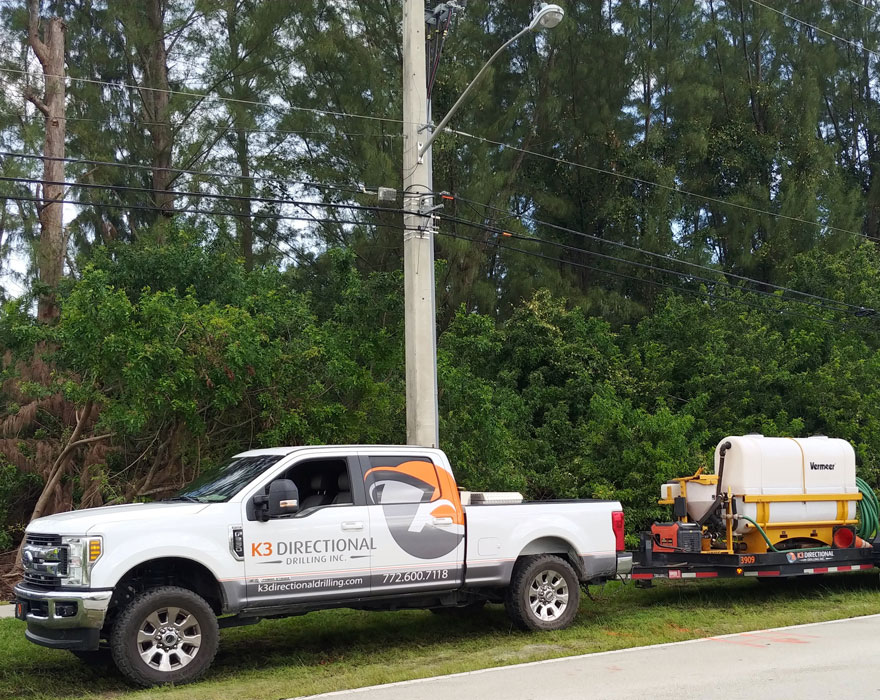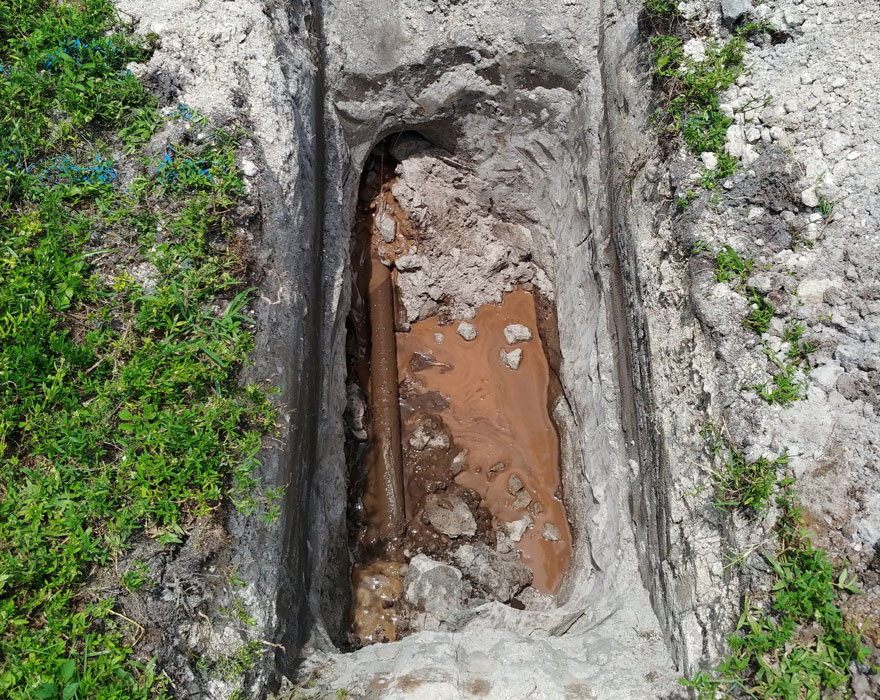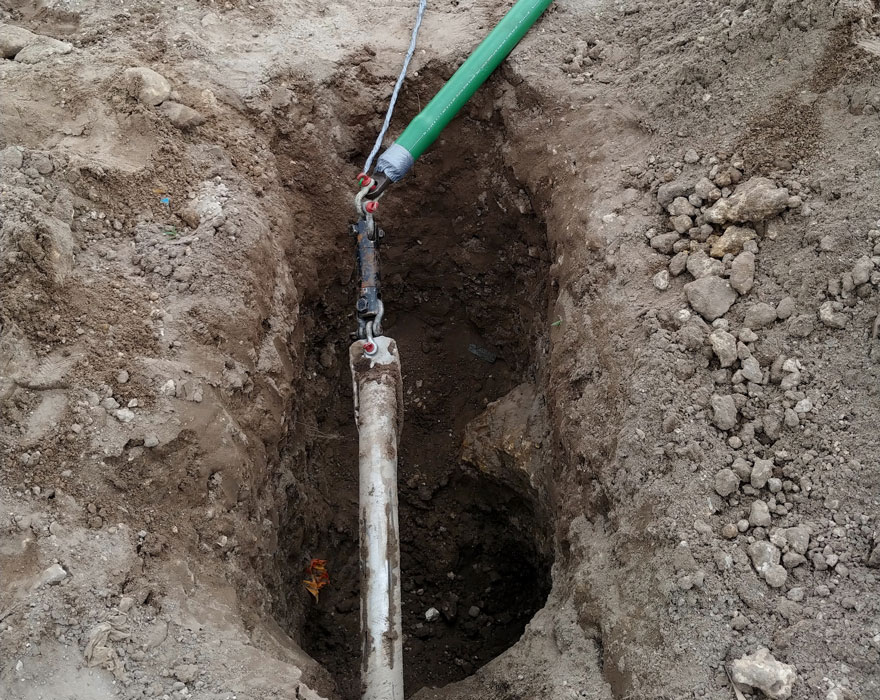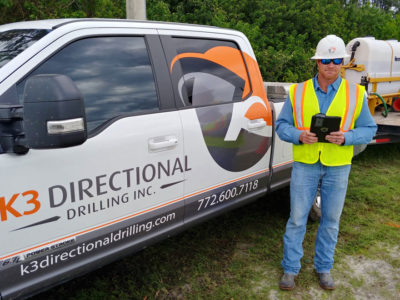K3 Directional Drilling completes 30 bores for The Villages retirement community
Two hundred feet (61 m) from the Florida Turnpike, the team at K3 Directional Drilling Inc., and their Vermeer D100x140 Navigator® horizontal directional drill is in the middle of a bore with dramatic changes in elevation and buried obstacles. By the time this project is completed, K3 Directional Drilling Project Manager Terry Mills (TJ) and his crew will have bored under the turnpike a total of 30 times over a 6-mile (9.7-km) area — each just as difficult as the last. However, through diligent planning and hard work, a highly trained team completed the underground utility expansion project for The Villages retirement community located near Leesburg and Wildwood, Florida.
Since 2010, The Villages planned retirement community has skyrocketed in size and population. Currently, more than 125,000 people over the age of 55 call The Villages home, but that number continues to expand as new housing developments and entertainment areas are added annually. K3 Directional Drilling’s part in the expansion is tying in new areas to existing gas, water and wastewater lines. However, there is one major obstacle in the way — the Florida Turnpike.
K3 Directional Drilling Vice President and General Manager Lewis Krantz said he was initially contacted by the general contractor on a new development near Wildwood, called The Villages of Southern Oaks. “I was asked to help design the bore plan,” explained Krantz. “Since we’ve opened our doors, we’ve made it a point to map out challenging projects ahead of time using the Vermeer BoreAid® design tool. The general contractor knew that and asked for my help before the ground was even broken. Well, fast-forward around a year later, and we got the call asking if we could come out and do the work, too.”

Adding drilling technology
Based on the starting elevation of each bore, the depths crews needed to be under the turnpike and the location of a high-pressure gas pipeline that several of the shots would have to cross, Lewis knew whoever did the work would certainly have their hands full. As it turns out, that person and crew would be his own.
TJ has been with K3 Directional Drilling since the company opened its doors, and he led the crew on this project. “We’ve changed a lot of our processes since opening our doors in the name of efficiency,” he explained. “Having the right equipment, tooling and technology helps us be more efficient on the job. It’s why we added a Vermeer R250C reclaimer a couple of years ago and started using Vermeer Projects productivity tools last year. The reclaimer gave us a better solution for managing used drilling slurry, and Vermeer Projects gave us more flexibility for planning bores on the job.”
Bore mapping for K3 Directional Drilling used to involve a crew member taking physical measurements of a job and then calling back to the office, so Krantz could input the measurements and create a plan on the computer. “For initial planning, that process is great, but when it comes to daily usage, it’s time-consuming, which is why we decided to try out Vermeer Projects,” said TJ. “Now, when we’re planning out our next drill shot, all I have to do is walk the path using a tablet loaded with Vermeer Projects and a GPS device. I can mark utilities or other obstacles, input any depth information and create a bore plan on the fly.” The team at K3 Directional Drilling started making Vermeer Projects part of their standard operating procedures around six months before tackling The Villages project, so everyone was well versed on how to use it. “All our crews are using it for large-diameter and more complicated bores,” said Krantz. “Our team back at the office also has access to the information and use it to create some really cool reports to share with customers when the work is completed.”

Planning the horizontal bore
According to TJ, using bore planning technology has saved the crew a few hours on almost every single bore. “The way this project was designed, we did a series of bores side by side that ranged in diameter, then we would move locations and do the same thing farther down the road,” he explained. “Since the diameter, location and the type of conduit being installed changed so frequently, we did preplanning work for almost every single shot. Having the ability to capture everything using GPS and plotting it into the program saved us a ton of time and provided a roadmap for the drill operator.”
The crew’s starting elevation was around 10 feet (304.8 cm) higher than the turnpike. Within that first 200 feet (61 m), bores needed to be 30 feet (9.1 cm) below the roadway. The terrain on the other side of the road was also lower and needed to be accounted for. Then, many of the bores crossed underneath a 36-inch (91.4-cm) gas distribution with a clearance of 10 feet (3 m) before exiting into a two-foot (.6-m) pit 40 feet (12.2 m) from the distribution line. It was not easy to plan.
“Planning this job was very challenging at times — a lot of math involved,” explained TJ. “We were installing a combination of steel and HDPE conduit, so we had to account for product bend radius while making sure we had the right pitches to get to the correct depths on each bore.”

Making the shot
With bore plan in hand, the K3 Directional Drilling setback their D100x140 an average of 200 feet (61 m) from the turnpike and drilled out distances ranging from 600 feet to 700 feet (182.9 m to 213.4 m). TJ, running the locator, helped the drill operator follow the roadmap created in Vermeer Projects. “We have a great team and are very good at communicating on the job, so once we had our plan put together, boring went pretty smoothly. When the bore path would approach the turnpike, I would confirm we were at the right depth and then cross to the other side and steer pitch until rods were pushed past the lanes of the turnpike. It worked out great, and we didn’t have to disrupt traffic.”
The 30 bores ranged from 12 inches to 36 inches (30.5 cm to 91.4 cm) in diameter, and the ground, for the most part, was all clay. The crew had to make several passes with drill reamers to open each bore to the required diameter before pulling back conduit. TJ said they used a combination of bentonite and an additive to help keep the clay from swelling and were pumping 180 gallons (681.4 L) of fluid a minute down the hole.
“On some of the larger installs, we had to make up to five passes with reamers before pulling back product,” said TJ. “With that many passes and having to swab the hole, each bore required a ton of fluid, and there wasn’t a water source. We had to truck it in. Thank goodness we had the R250C reclaimer there. It saved us a bunch of time and helped reduce our operating costs.”

Looping in the customer
The 30 bores that K3 Directional Drilling completed at The Villages project happened over a nine-month time frame, and through the use of Vermeer Projects, they kept the customer informed every step of the way. “Our team in the field would send bore profile information every time another shot was done, and the folks in the office would then update the customer,” said Krantz. “It kept everyone in the loop — they appreciated it.”
Equipment, technology and a great team all working together helped elevate the performance of the K3 Directional Drilling crew on The Villages new development project. It’s a winning combination that Krantz and TJ will take with them on the next challenging project.
This article contains third-party observations, advice or experiences that do not necessarily reflect the opinions of Vermeer Corporation, its affiliates or its dealers. Testimonials and/or endorsements by contractors in specific circumstances may not be representative of normal circumstances experienced by all customers.
Vermeer Corporation reserves the right to make changes in product engineering, design and specifications; add improvements; or discontinue manufacturing or distribution at any time without notice or obligation. Equipment shown is for illustrative purposes only and may display optional accessories or components specific to their global region. Please contact your local Vermeer dealer for more information on machine specifications.
Vermeer, the Vermeer logo, Navigator and BoreAid are trademarks of Vermeer Manufacturing Company in the U.S. and/or other countries.
